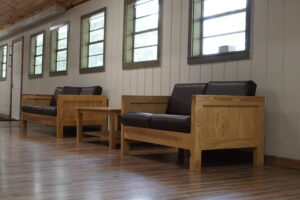Starting care for your child or teen is a big decision. Our admissions process is designed to be clear, compassionate, and fast, so your family can move from uncertainty to a plan. This guide walks you through how to start, what information we need, how we determine clinical fit, what admission day looks like, and how we prepare you for the weeks that follow. You’ll also find links to helpful BlueRock pages and trusted, non-commercial resources for added clarity.
Who We Serve (And How Admissions Supports That)
BlueRock provides structured, relationship-based residential treatment for adolescents. Our team focuses on safety, skills practice, academics support, and family involvement. If you’re wondering whether our program is the right level of care, our admissions specialists will walk you through a brief screening call and outline next steps right away. For any questions as you read, please contact our admissions team.
Not sure where residential care fits on the continuum? The American Academy of Child & Adolescent Psychiatry (AACAP) explains how inpatient and residential services support youth who need more structure than outpatient care can provide; see AACAP’s overview of inpatient and residential care. For general background on youth mental health, explore NIMH’s child and adolescent mental health topic page.
How To Start
Call or submit our form. Reach an admissions specialist by phone or start a secure message through our Contact page.
Brief pre-screen (10-20 minutes). We ask about current concerns, recent evaluations, safety needs, diagnoses (if known), medications, and prior treatment. We also discuss timing, insurance/funding, and whether you have school or testing records available.
Next-step checklist. Before we hang up, we’ll give you a short list of items to gather and a target timeline for an admission decision. If residential is not the best fit, we’ll help you identify alternatives and referrals.

What We Request After Your First Call
To make a timely, clinically sound decision, we typically request:
1) Recent clinical records. Any psychiatric/psychological evaluations, hospital discharge summaries, therapy notes, and medication lists. If you do not have copies, we can provide release forms to help us coordinate with providers.
2) Education information. Recent report cards, attendance summaries, 504/IEP documents if applicable, and any relevant testing. If you need context on education plans and privacy, AACAP’s Facts for Families series is a good primer for caregivers.
3) Family and safety details. We ask about family strengths, supports, and any current safety plans so we can plan appropriately for admission and early stabilization.
How We Determine Level Of Care And Clinical Fit
We use a comprehensive, biopsychosocial assessment to understand your child’s needs. We consider safety, co-occurring conditions, functioning at home and school, and what has or hasn’t helped before. Our goal is to match each youth to the least restrictive level of care that can safely meet their needs—aligned with nationally recognized frameworks for adolescent treatment. (For a deeper dive on level-of-care decision-making in youth services, see the ASAM adolescent framework.) If we believe a different level of care is more appropriate, we will explain why and support a warm handoff to providers that fit your situation.
Insurance, Funding, And Timing
Before admission, our team reviews funding options, verifies benefits when applicable, and clarifies any out-of-pocket responsibility. We give you a written summary in plain language so costs never block needed care. Federal parity protections require most plans that cover behavioral health to treat those benefits comparably to medical/surgical benefits; see the CMS overview of the Mental Health Parity and Addiction Equity Act and the U.S. Department of Labor summary of recent rules.
What Happens Between Approval And Arrival
Once clinically approved, we work with you on a clear arrival plan:
Medical coordination. We review medications and any needed lab work or clearances. If adjustments are recommended, our clinicians coordinate with your current providers.
Packing and policies. To make arrival easier, we share our current packing guidance and policy highlights (phones, visiting, technology, and valuables).
Academic coordination. Our education team works with your school on records and any IEP/504 arrangements so classroom time begins smoothly. Learn how we support learning on our Academics page.
Help for your teen when they need it most.
Admission Day: What To Expect
Families arrive at our welcome center at the scheduled time. You’ll meet staff from admissions, nursing, and your child’s treatment team. We complete a focused safety screen, finalize consent forms, review medications, and answer last-minute questions.
We also walk your child through the first-day schedule—room orientation, peer introductions, a tour, and time to settle in. We know the first day can feel overwhelming, so we pace the process and keep you informed.
Privacy And Your Family’s Rights
Your health information is protected under the HIPAA Privacy Rule. If your child receives substance use services, additional federal confidentiality rules may apply (see the HHS fact sheet on 42 CFR Part 2). We explain consents and information sharing during intake and honor your preferences for who receives updates.
How Treatment Planning Works
Within the first few days, the team completes comprehensive assessments and drafts an initial treatment plan. We set measurable goals with you and your child, align academic supports, and establish a communication schedule with your family and community providers. You’ll learn how therapy, skills practice, and experiential activities fit together across the week.
Family Participation And Communication
Family involvement improves outcomes and helps transitions home go smoother. We encourage scheduled calls, family sessions when clinically appropriate, and caregiver education.
Education And Daily Structure
Your child follows a predictable, supportive daily schedule that blends school time, therapy, skills practice, wellness, and recreation. Structure helps reduce anxiety and supports progress. (For context on why predictable routines matter in inpatient settings, AACAP offers caregiver-friendly explainers; see Facts for Families.)
Length Of Stay And Step-Down Planning
Length of stay depends on clinical progress and goals. From the first week, we plan for what comes next—step-down services, outpatient therapy, school transition, and community supports. Our team coordinates with you to set appointments, share records, and build a safety and relapse-prevention plan tailored to your family. If you’re comparing options or need a locator for services near home, try FindTreatment.gov (you can filter by services, insurance, and age group).
FAQs: Quick Answers About Admissions
How fast can admission happen? Timing depends on bed availability, clinical fit, documentation, and insurance. Our admissions team will give you a realistic timeline on your first call.
Do you help with school? Yes. Our education team coordinates with your district and supports IEP/504 plans so academics continue during treatment. See Academics.
How do you keep us informed? We schedule routine updates and family sessions when clinically appropriate, and we’re available for questions between touchpoints.
Next Steps
We’re here to help you move from concern to a plan. Start a confidential conversation through our Contact form. If you are experiencing an immediate safety concern, call 911 or the 988 Suicide & Crisis Lifeline now.





















